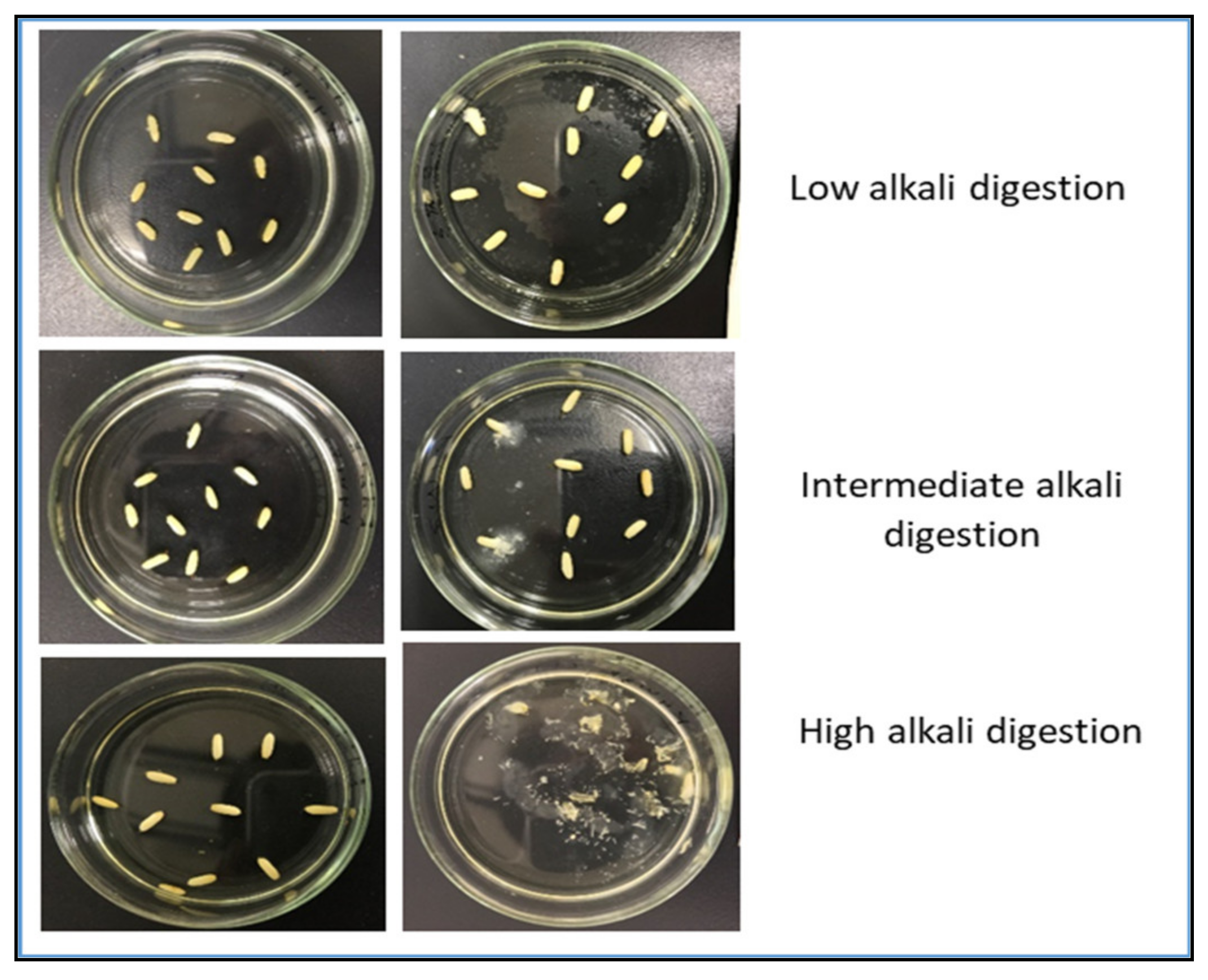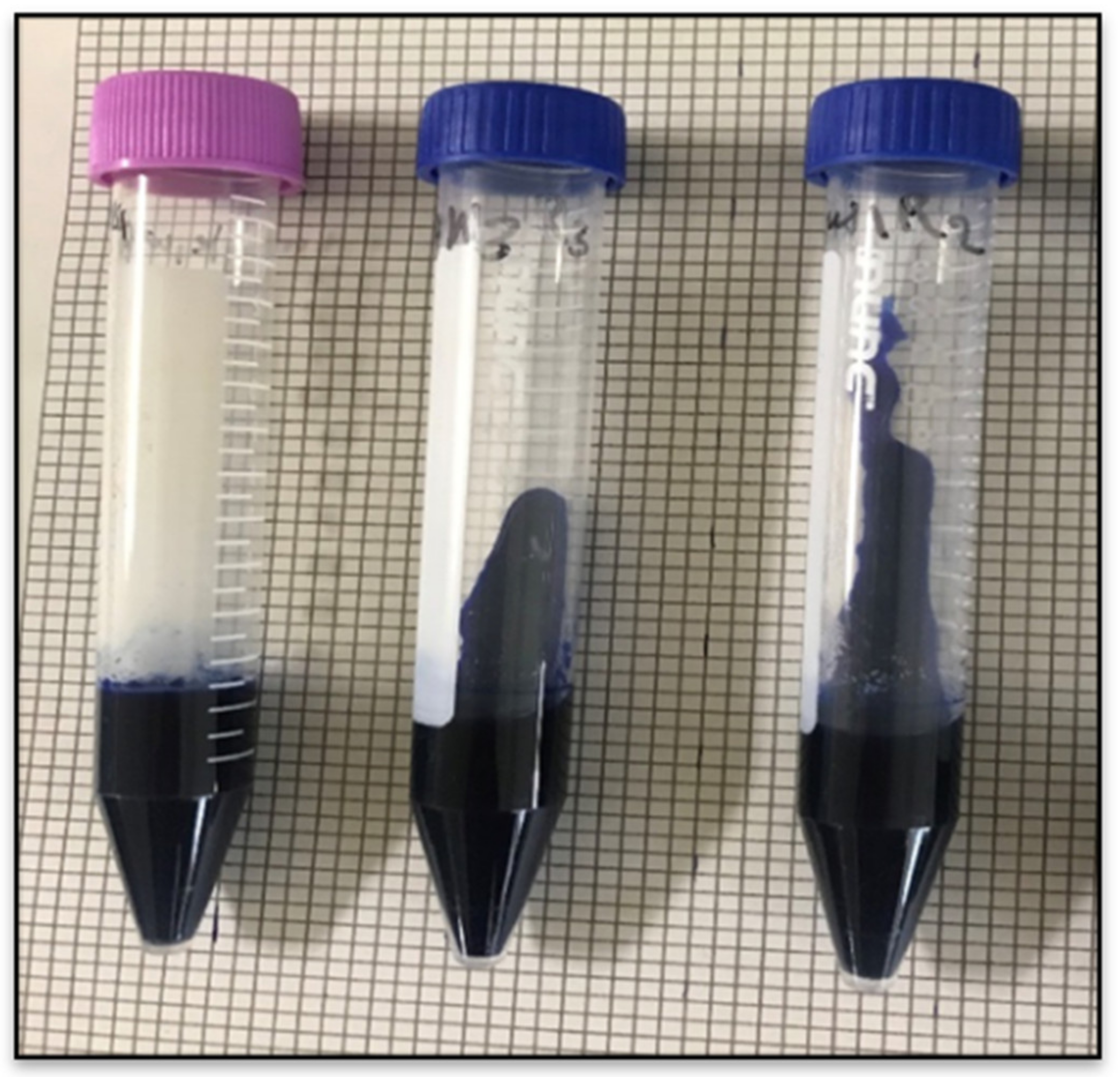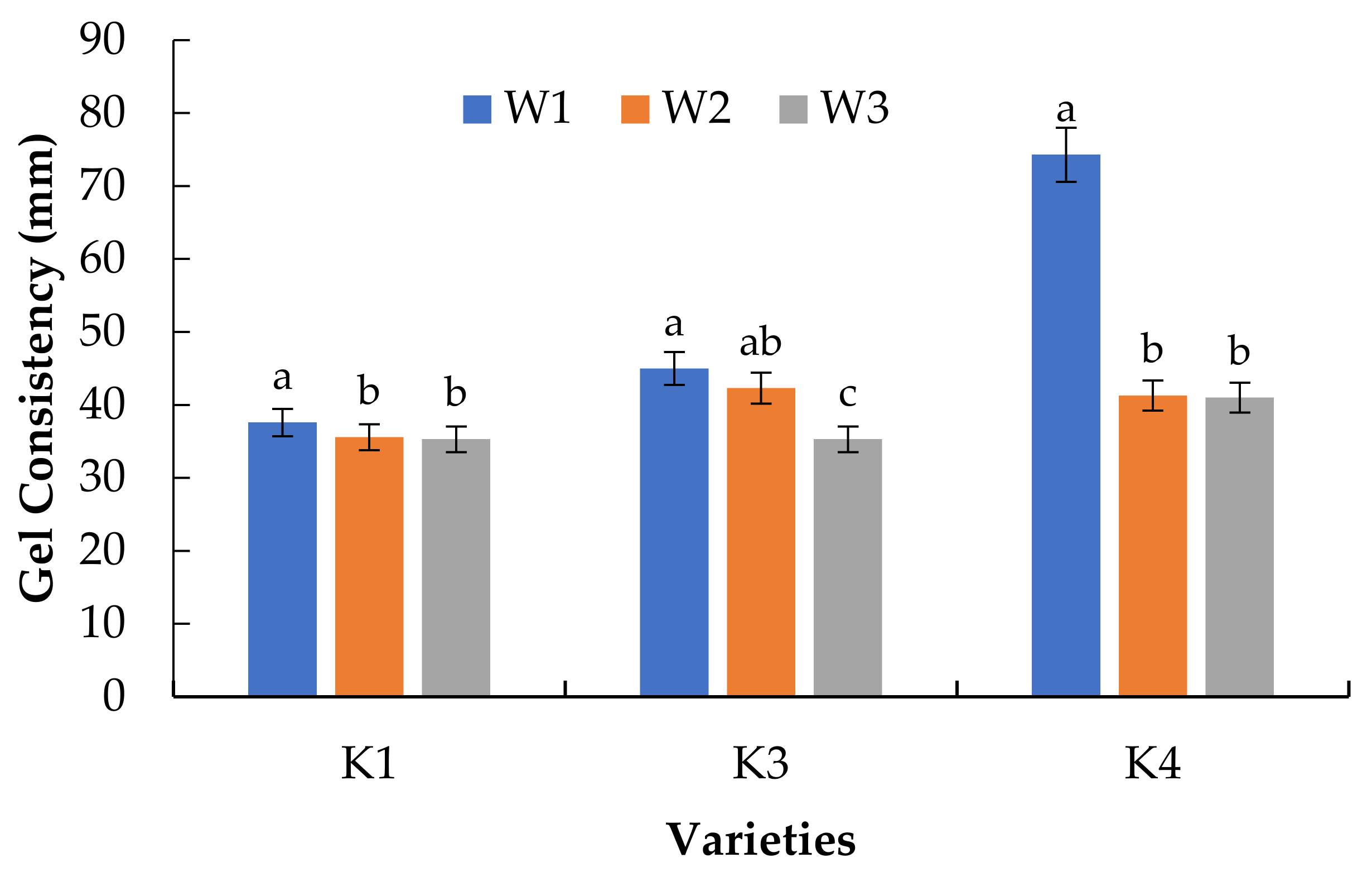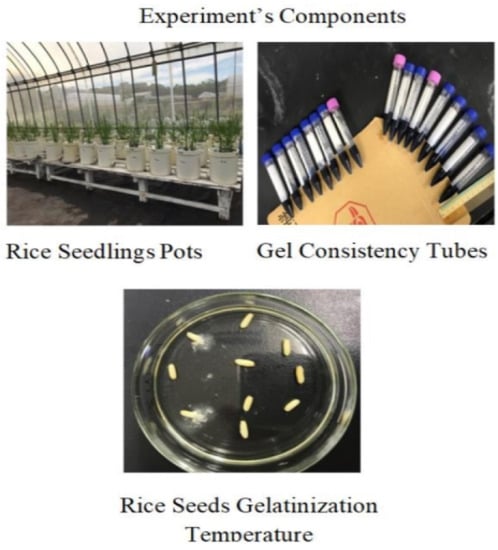Efficacy of Irrigation Interval after Anthesis on Grain Quality, Alkali Digestion, and Gel Consistency of Rice
Abstract
1. Introduction
2. Materials and Methods
2.1. Materials and Experiment Design
2.2. Grain Quality Measurement
2.3. Chemicals
2.4. Determination of Gelatinization Temperature (GT)
2.5. Determination of Gel Consistency
- -> Very shelly rice with hard gel consistency (gel length, <40 mm)
- -> Shelly rice with medium gel consistency (gel length, 41–60 mm)
- -> Soft rice with soft gel consistency (gel length, >60 mm)
2.6. Data Analysis
3. Results
3.1. Grain Quality Contents
3.2. Gelatinization Temperature (GT)
3.3. Gel Consistency (GC)
4. Discussion
5. Conclusions
Author Contributions
Funding
Institutional Review Board Statement
Informed Consent Statement
Data Availability Statement
Conflicts of Interest
References
- Xuan, T.D.; Minh, T.N.; Khanh, T.D. Allelopathic momilactones A and B are implied in rice drought and salinity tolerance, not weed resistance. Agron. Sustain. Dev. 2016, 36, 52. [Google Scholar] [CrossRef]
- Kakar, K.; Xuan, T.D.; Haqani, M.I.; Rayee, R.; Wafa, I.K.; Abdiani, S.; Tran, H.D. Current situation and sustainable development for rice cultivation and production in Afghanistan. Agriculture 2019, 9, 49. [Google Scholar] [CrossRef]
- Wei, C.; Kwon, O.Y.; Liu, X.W.; Kim, H.C.; Yoon, W.K.; Kim, H.M.; Kim, M.R. Protein profiles of major Korean rice cultivars. Prev. Nutr. Food Sci. 2007, 12, 103–110. [Google Scholar] [CrossRef]
- Kakar, K.; Xuan, T.D.; Abdiani, S.; Wafa, I.K.; Noori, Z.; Attai, S.; Khanh, T.D.; Tran, H.D. Morphological observation and correlation of growth and yield characteristics with grain quality and antioxidant activities in exotic rice varieties of Afghanistan. Agriculture 2019, 9, 167. [Google Scholar] [CrossRef]
- Kakar, K.; Nitta, Y.; Asagi, N.; Komatsuzaki, M.; Shiotau, F.; Kokubo, T.; Xuan, T.D. Morphological analysis on comparison of organic and chemical fertilizers on grain quality of rice at different planting densities. Plant Prod. Sci. 2019, 22, 510–518. [Google Scholar] [CrossRef]
- Rayee, R.; Xuan, T.D.; Kakar, K.; Haqani, M.I. Antioxidant activity, quality parameters and grain characteristics of rice varieties of Afghanistan. Int. Lett. Nat. Sci. 2019, 73, 26. [Google Scholar] [CrossRef]
- Pandey, A.; Kumar, A.; Pandey, D.S.; Thongbam, P.D. Rice quality under water stress. Indian J. Adv. Plant Res. 2014, 1, 23–26. [Google Scholar]
- Matsuura, A.; Tsuji, W.; An, P.; Inanaga, S.; Murata, K. Effect of pre-and post-heading water deficit on growth and grain yield of four millets. Plant Prod. Sci. 2012, 15, 323–331. [Google Scholar] [CrossRef]
- Sepaskhah, A.R.; Yousofi-Falakdehi, A. Interaction between the effects of deficit irrigation and water salinity on yield and yield components of rice in pot experiment. Plant Prod. Sci. 2009, 12, 168–175. [Google Scholar] [CrossRef]
- Cai, Y.; Wang, W.; Zhu, Z.; Zhang, Z.; Lang, Y.; Zhu, Q. Effects of water stress during grain-filling period on rice grain yield and its quality under different nitrogen levels. J. Appl. Ecol. 2006, 17, 1201–1206. [Google Scholar]
- Fofana, M.; Cherif, M.; Kone, B.; Futakuchi, K.; Audebert, A. Effect of water deficit at grain repining stage on rice grain quality. J. Agr. Biotech. Sustain. Dev. 2010, 2, 100–107. [Google Scholar]
- Sidiqui, S.U.; Kummamaru, T.; Satoh, H. Pakistan rice genetic resources-I: Grain morphological diversity and its distribution. Pak. J. Bot. 2007, 39, 841–848. [Google Scholar]
- Sattari, A.; Mahdinezhad, N.; Fakheri, B.; Noroozi, M.; Beshishtizadeh, H. Improvement of the eating and cooking qualities of rice: A review. Int. J. Farm Allied. Sci. 2015, 4, 153–160. [Google Scholar]
- Cruz, N.D.; Khush, G.S. Rice grain quality evaluation procedures. In Aromatic Rices; International Rice Research Institute: Los Bnos, Philippines, 2000; Volume 3, pp. 15–28. [Google Scholar]
- Rohilla, R.; Singh, V.P.; Singh, U.S.; Singh, R.; Khush, G.S. Crop husbandry and environmental factors affecting aroma and other quality traits. In Aromatic Rices; Oxford and IBH Publishing Co. Pvt. Ltd.: New Delhi, India, 2000; pp. 201–216. [Google Scholar]
- Kakar, K.; Xuan, T.D.; Quan, N.V.; Wafa, I.K.; Tran, H.-D.; Khanh, T.D.; Dat, T.D. Efficacy of N-methyl-N-nitrosourea (MNU) mutation on enhancing the yield and quality of rice. Agriculture 2019, 9, 212. [Google Scholar] [CrossRef]
- Cagampang, G.B.; Perez, C.M.; Juliano, B.O. A gel consistency test for eating quality of rice. J. Sci. Food. Agri. 1973, 24, 1589–1594. [Google Scholar] [CrossRef]
- Wang, L.Q.; Liu, W.J.; Xu, Y..; He, Y.Q.; Luo, L.J.; Xing, Y.Z.; Xu, C.G.; Zhang, Q. Genetic basis of 17 traits and viscosity parameters characterizing the eating and cooking quality of rice grain. Theor. Appl. Genet. 2007, 115, 463–476. [Google Scholar] [CrossRef]
- Fan, C.C.; Yu, X.Q.; Xing, Y.Z.; Xu, C.G.; Luo, L.J. The main effects epistatic effects and environmental interaction of QTLs on the cooking and eating quality of rice in doubled-haploid line population. Theor. Appl. Genet. 2005, 110, 1445–1452. [Google Scholar] [CrossRef] [PubMed]
- Rayee, R.; Tran, H.D.; Xuan, T.D.; Khanh, T.D. Imposed water deficit after anthesis for the improvement of macronutrients, quality, phytochemicals, and antioxidants in rice grain. Sustainability 2018, 10, 4843. [Google Scholar] [CrossRef]
- Chemutai, L.R.; Musyoki, M.A.; Kioko, W.F.; Mwenda, N.S.; Muriira, K.G. Physicochemical characterization of selected rice (Oryza sativa L.) genotypes based on gel consistency and alkali digestion. Anal. Biochem. 2016, 5, 285. [Google Scholar] [CrossRef]
- Graham, R. A Proposal for IRRI to Establish a Grain Quality and Nutrition Research Center; IRRI: Los Baños, Philippines, 2002. [Google Scholar]
- Kakar, K.; Xuan, T.D.; Quan, N.V.; Wafa, I.K.; Tran, H.D.; Khanh, T.D.; Dat, T.D. Efficacy of N-methyl-N-nitrosourea mutation on physicochemical properties, phytochemicals, and momilactones A and B in rice. Sustainability 2019, 11, 6862. [Google Scholar] [CrossRef]
- Renmin, W.; Yuanshu, D. Studies on ecological factors of rice from heading to maturity I. Effect of different soil moisture content on fertilization, grain-filling and grain quality of early Indica rice. J. Zhejiang Agri. Univ. Sci. 1989, 15, 14–20. [Google Scholar]
- Dingkuhn, M.; LeGal, P.Y. Effect of drainage date on yield and dry matter partitioning in irrigated rice. Field Crops Res. 1996, 46, 117–126. [Google Scholar] [CrossRef]
- Zainl, N.A.M.; Ismailm, M.R.; Puteh, A.; Mahmood, M.; Islam, M.R. Impact of cyclic water stress on growth, physiological responses and yield of rice (Oryza sativa L.) grown in tropical environment. Ciência Rural 2014, 44, 2136–2141. [Google Scholar] [CrossRef]
- Ishima, T. Effect of nitrogenous fertilizer application and protein content in milled rice on organoleptic quality of cooked rice. Rep. Natl. Food Res. Inst. 1974, 29, 9–15. [Google Scholar]
- Noori, Z.; Qarluq, A.G.; Kakar, K.; Abdiani, S.; Nawakht, N.A. Comparison of physicochemical properties, grain quality, and ultrastructure of rice cultivars. IJIRSS 2020, 3, 31–42. [Google Scholar]
- Juliano, B. O. Rice Chemistry and Quality; Philippine Rice Research Institute: Manila, Philippines, 2003; pp. 25–39. [Google Scholar]
- Waters, D.L.; Henry, R.J.; Reinke, R.F.; Fitzgerald, M.A. Gelatinization temperature of rice explained by polymorphisms in starch synthase. Plant Biotechnol. J. 2006, 4, 115–122. [Google Scholar] [CrossRef] [PubMed]
- Campus, H.J.; Engineering, B.; Campus, H.J. Analysis of genotypic and environmental effects on rice starch. 1. Apparent amylose content pasting viscosity, and gel texture. Field Crops Res. 2004, 52, 6010–6016. [Google Scholar]
- Wanchana, S.; Toojinda, T.; Tragoonrung, S.; Vanavichit, A. Duplicated coding sequence in the waxy allele of tropical glutinous rice (Oryza sativa L.). Plant Sci. 2003, 165, 1193–1199. [Google Scholar] [CrossRef]
- Tran, N.A.; Daygon, V.D.; Resurreccion, A.P.; Cuevas, R.P.; Corpuz, H.M.; Fitzgerald, M.A. Single nucleotide polymorphism in the waxy gene explains a significant component of gel consistency. Theor. Appl. Genet. 2011, 123, 519–525. [Google Scholar] [CrossRef]



| Values | Degree of Dispersion | Alkali Digestion | Gelatinization Temperature |
|---|---|---|---|
| 1 | Grain not affected | Low | High |
| 2 | Swollen grain | Low | High |
| 3 | Inflated grain with imperfect and narrow collar | Low or intermediate | High-intermediate |
| 4 | Inflated grain with perfect and wide collar | Intermediate | Intermediate |
| 5 | Fragmented grain, perfect or wide collar | Intermediate | Intermediate |
| 6 | Dispersed grain, merging with collar | High | Low |
| 7 | Grain completely dispersed and intermingled | High | Low |
| Variety | Treatments | Protein (%) | Amylose (%) | Fatty Acid (%) |
|---|---|---|---|---|
| K1 | W1 | 6.83 ± 0.78 b | 22.43 ± 0.44 a | 7.67 ± 3.18 a |
| W2 | 8.63 ± 0.80 ab | 19.14 ± 0.57 b | 5.00 ± 0.58 a | |
| W3 | 9.70 ± 0.28 a | 17.56 ± 0.60 b | 9.67 ± 2.73 a | |
| K3 | W1 | 6.53 ± 0.46 b | 22.30 ± 1.00 a | 8.33 ± 3.84 a |
| W2 | 8.30 ± 0.60 ab | 19.10 ± 1.10 ab | 9.00 ± 0.57 a | |
| W3 | 10.16 ± 0.60 a | 16.33 ± 0.88 b | 10.00 ± 1.00 a | |
| K4 | W1 | 6.63 ± 0.68 b | 22.00 ± 0.72 a | 4.33 ± 0.88 a |
| W2 | 9.46 ± 0.48 a | 21.50 ± 1.50 a | 4.00 ± 0.00 a | |
| W3 | 9.93 ± 0.60 a | 18.20 ± 1.10 a | 3.66 ± 0.33 a | |
| ANOVA | ||||
| Variety | NS | NS | * | |
| Treatment | * | * | NS | |
| Variety × Treatment | NS | NS | NS | |
| Varieties | Treatments | Alkali Digestion Value | Alkali Digestion | Gelatinization Temperature |
|---|---|---|---|---|
| K1 | W1 | 2 | Low | High |
| W2 | 3 | Intermediate | Intermediate | |
| W3 | 4 | Intermediate | Intermediate | |
| K3 | W1 | 2 | Low | High |
| W2 | 4 | High-intermediate | High-intermediate | |
| W3 | 3 | Intermediate | Intermediate | |
| K4 | W1 | 2 | Low | High |
| W2 | 4 | Intermediate | Intermediate | |
| W3 | 6 | High | Low |
Publisher’s Note: MDPI stays neutral with regard to jurisdictional claims in published maps and institutional affiliations. |
© 2021 by the authors. Licensee MDPI, Basel, Switzerland. This article is an open access article distributed under the terms and conditions of the Creative Commons Attribution (CC BY) license (https://creativecommons.org/licenses/by/4.0/).
Share and Cite
Rayee, R.; Xuan, T.D.; Khanh, T.D.; Tran, H.-D.; Kifayatullah, K. Efficacy of Irrigation Interval after Anthesis on Grain Quality, Alkali Digestion, and Gel Consistency of Rice. Agriculture 2021, 11, 325. https://doi.org/10.3390/agriculture11040325
Rayee R, Xuan TD, Khanh TD, Tran H-D, Kifayatullah K. Efficacy of Irrigation Interval after Anthesis on Grain Quality, Alkali Digestion, and Gel Consistency of Rice. Agriculture. 2021; 11(4):325. https://doi.org/10.3390/agriculture11040325
Chicago/Turabian StyleRayee, Ramin, Tran Dang Xuan, Tran Dang Khanh, Hoang-Dung Tran, and Kakar Kifayatullah. 2021. "Efficacy of Irrigation Interval after Anthesis on Grain Quality, Alkali Digestion, and Gel Consistency of Rice" Agriculture 11, no. 4: 325. https://doi.org/10.3390/agriculture11040325
APA StyleRayee, R., Xuan, T. D., Khanh, T. D., Tran, H.-D., & Kifayatullah, K. (2021). Efficacy of Irrigation Interval after Anthesis on Grain Quality, Alkali Digestion, and Gel Consistency of Rice. Agriculture, 11(4), 325. https://doi.org/10.3390/agriculture11040325











